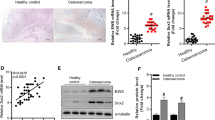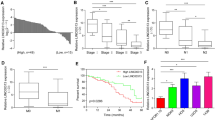Abstract
Introduction
Osteosarcoma is the most common malignancy in children, with high morbidity worldwide. Researches indicated that long non-coding RNAs (lncRNAs) played crucial roles in various cancers. Nevertheless, study investigating lncRNA long intergenic non-protein coding RNA 1089 (LINC01089) in osteosarcoma is extremely rare. Thus, the research of LINC01089 is of great significance.
Materials and methods
qRT-PCR and western blot were done to test the expression of RNAs and proteins in osteosarcoma cells. Functional assays were carried out to evaluate biological behaviors of hFOB1.19 and osteosarcoma cells with or without LINC01089 knockdown and overexpression. In vitro and in vivo experiments in a rescue manner were performed to reveal the influences of LINC01089 and Hippo pathway on osteosarcoma cell phenotype and tumor growth.
Results
LINC01089 was down-regulated in osteosarcoma cells and overexpressing LINC01089 was validated to restrain cell growth in vitro and tumor growth in vivo. Additionally, silencing LINC01089 could exacerbate cell malignant behaviors. Correlation of LINC01089 and Hippo pathway was proved. Overexpressing LINC01089 could activate Hippo pathway to exert antitumor effects.
Conclusion
LINC01089 could restrain the progression of osteosarcoma through activating Hippo pathway.





Similar content being viewed by others
References
Cho Y, Jung GH, Chung SH, Kim JY, Choi Y, Kim JD (2011) Long-term survivals of stage IIb osteosarcoma: a 20 year experience in a single institution (in eng). Clin Orthop Surg 3:48–54. https://doi.org/10.4055/cios.2011.3.1.48
Savage SA, Mirabello L (2011) Using epidemiology and genomics to understand osteosarcoma etiology (in eng). Sarcoma 2011:548151. https://doi.org/10.1155/2011/548151
Broadhead ML, Clark JC, Myers DE, Dass CR, Choong PF (2011) The molecular pathogenesis of osteosarcoma: a review (in eng). Sarcoma 2011:959248. https://doi.org/10.1155/2011/959248
Mo JS, Park HW, Guan KL (2014) The hippo signaling pathway in stem cell biology and cancer (in eng). EMBO Rep 15:642–656. https://doi.org/10.15252/embr.201438638
Taha Z, Janse van Rensburg HJ, Yang X (2018) The hippo pathway: immunity and cancer (in eng). Cancers. https://doi.org/10.3390/cancers10040094
Jeong SH, Kim HB, Kim MC, Lee JM, Lee JH, Kim JH, Kim JW, Park WY, Kim SY, Kim JB, Kim H, Kim JM, Choi HS, Lim DS (2018) Hippo-mediated suppression of IRS2/AKT signaling prevents hepatic steatosis and liver cancer (in eng). J Clin Investig 128:1010–1025. https://doi.org/10.1172/jci95802
Dong L, Lin F, Wu W, Liu Y, Huang W (2018) Verteporfin inhibits YAP-induced bladder cancer cell growth and invasion via Hippo signaling pathway (in eng). Int J Med Sci 15:645–652. https://doi.org/10.7150/ijms.23460
Hou L, Chen L, Fang L (2017) Scutellarin Inhibits proliferation, invasion, and tumorigenicity in human breast cancer cells by regulating HIPPO-YAP signaling pathway (in eng). Med Sci Monit 23:5130–5138. https://doi.org/10.12659/msm.904492
Renganathan A, Felley-Bosco E (2017) Long noncoding RNAs in cancer and therapeutic potential (in eng). Adv Exp Med Biol 1008:199–222. https://doi.org/10.1007/978-981-10-5203-3_7
Bhan A, Soleimani M, Mandal SS (2017) Long noncoding RNA and cancer: a new paradigm (in eng). Can Res 77:3965–3981. https://doi.org/10.1158/0008-5472.Can-16-2634
Xiao J, Lv Y, Jin F, Liu Y, Ma Y, Xiong Y, Liu L, Zhang S, Sun Y, Tipoe GL, Hong A, Xing F, Wang X (2017) LncRNA HANR promotes tumorigenesis and increase of chemoresistance in hepatocellular carcinoma (in eng). Cell physiol biochem 43:1926–1938. https://doi.org/10.1159/000484116
Wei GH, Wang X (2017) lncRNA MEG3 inhibit proliferation and metastasis of gastric cancer via p53 signaling pathway (in eng). Eur Rev Med Pharmacol Sci 21:3850–3856
Sas-Chen A, Aure MR, Leibovich L, Carvalho S, Enuka Y, Korner C, Polycarpou-Schwarz M, Lavi S, Nevo N, Kuznetsov Y, Yuan J, Azuaje F, Ulitsky I, Diederichs S, Wiemann S, Yakhini Z, Kristensen VN, Borresen-Dale AL, Yarden Y (2016) LIMT is a novel metastasis inhibiting lncRNA suppressed by EGF and downregulated in aggressive breast cancer (in eng). EMBO Mol Med 8:1052–1064. https://doi.org/10.15252/emmm.201606198
Sinegubova MV, Orlova NA, Kovnir SV, Dayanova LK, Vorobiev II (2021) High-level expression of the monomeric SARS-CoV-2 S protein RBD 320–537 in stably transfected CHO cells by the EEF1A1-based plasmid vector (in eng). PLoS ONE 16:e0242890. https://doi.org/10.1371/journal.pone.0242890
Dey A, Varelas X, Guan KL (2020) Targeting the hippo pathway in cancer, fibrosis, wound healing and regenerative medicine (in eng). Nat Rev Drug Discov 19:480–494. https://doi.org/10.1038/s41573-020-0070-z
Calses PC, Crawford JJ, Lill JR, Dey A (2019) Hippo pathway in cancer: aberrant regulation and therapeutic opportunities (in eng). Trends in cancer 5:297–307. https://doi.org/10.1016/j.trecan.2019.04.001
Al-Rugeebah A, Alanazi M, Parine NR (2019) MEG3: an Oncogenic long non-coding rna in different cancers (in eng). Pathol oncol res Pathology 25:859–874. https://doi.org/10.1007/s12253-019-00614-3
Zhang C, Hao Y, Wang Y, Xu J, Teng Y, Yang X (2018) TGF-β/SMAD4-regulated LncRNA-LINP1 inhibits epithelial-mesenchymal transition in lung cancer (in eng). Int J Biol Sci 14:1715–1723. https://doi.org/10.7150/ijbs.27197
Liu K, Hou Y, Liu Y, Zheng J (2017) LncRNA SNHG15 contributes to proliferation, invasion and autophagy in osteosarcoma cells by sponging miR-141 (in eng). J Biomed Sci 24:46. https://doi.org/10.1186/s12929-017-0353-9
Qu G, Ma Z, Tong W, Yang J (2018) LncRNA WWOXAS1 inhibits the proliferation, migration and invasion of osteosarcoma cells (in eng). Mol Med Rep 18:779–788. https://doi.org/10.3892/mmr.2018.9058
Wang W, Luo P, Guo W, Shi Y, Xu D, Zheng H, Jia L (2018) LncRNA SNHG20 knockdown suppresses the osteosarcoma tumorigenesis through the mitochondrial apoptosis pathway by miR-139/RUNX2 axis (in eng). Biochem Biophys Res Commun 503:1927–1933. https://doi.org/10.1016/j.bbrc.2018.07.137
Meng Z, Moroishi T, Guan KL (2016) Mechanisms of Hippo pathway regulation (in eng). Genes Dev 30:1–17. https://doi.org/10.1101/gad.274027.115
Zygulska AL, Krzemieniecki K, Pierzchalski P (2017) Hippo pathway - brief overview of its relevance in cancer (in eng). J physiol pharmacol 68:311–335
Fu V, Plouffe SW, Guan KL (2017) The Hippo pathway in organ development, homeostasis, and regeneration (in eng). Curr Opin Cell Biol 49:99–107. https://doi.org/10.1016/j.ceb.2017.12.012
Ahmed AA, Mohamed AD, Gener M, Li W, Taboada E (2017) YAP and the hippo pathway in pediatric cancer (in eng). Mol cell oncol 4:e1295127. https://doi.org/10.1080/23723556.2017.1295127
Zhang M, Zhao Y, Zhang Y, Wang D, Gu S, Feng W, Peng W, Gong A, Xu M (2018) LncRNA UCA1 promotes migration and invasion in pancreatic cancer cells via the Hippo pathway (in eng). Biochim Biophys Acta 1864:1770–1782. https://doi.org/10.1016/j.bbadis.2018.03.005
Wu DM, Wang S, Wen X, Han XR, Wang YJ, Shen M, Fan SH, Zhang ZF, Shan Q, Li MQ, Hu B, Lu J, Chen GQ, Zheng YL (2018) LncRNA SNHG15 acts as a ceRNA to regulate YAP1-Hippo signaling pathway by sponging miR-200a-3p in papillary thyroid carcinoma (in eng). Cell Death Dis 9:947. https://doi.org/10.1038/s41419-018-0975-1
Zhao W, Zhang LN, Wang XL, Zhang J, Yu HX (2019) Long noncoding RNA NSCLCAT1 increases non-small cell lung cancer cell invasion and migration through the hippo signaling pathway by interacting with CDH1 (in eng). FASEB J 33:1151–1166. https://doi.org/10.1096/fj.201800408R
Acknowledgements
We appreciate the support of our experimenters.
Funding
The study was supported by the National Natural Science Foundation of China (81973871); Supported by Shanghai Key Clinical Specialty “Orthopedics and Trauma of Traditional Chinese Medicine” (shslczdzk03901).
Author information
Authors and Affiliations
Corresponding authors
Ethics declarations
Conflict of interest
All authors have no conflicts of interest.
Additional information
Publisher's Note
Springer Nature remains neutral with regard to jurisdictional claims in published maps and institutional affiliations.
Supplementary Information
Below is the link to the electronic supplementary material.
About this article
Cite this article
Zhang, H., Zhou, L., Hu, S. et al. The crosstalk between LINC01089 and hippo pathway inhibits osteosarcoma progression. J Bone Miner Metab 40, 890–899 (2022). https://doi.org/10.1007/s00774-022-01377-9
Received:
Accepted:
Published:
Issue Date:
DOI: https://doi.org/10.1007/s00774-022-01377-9




